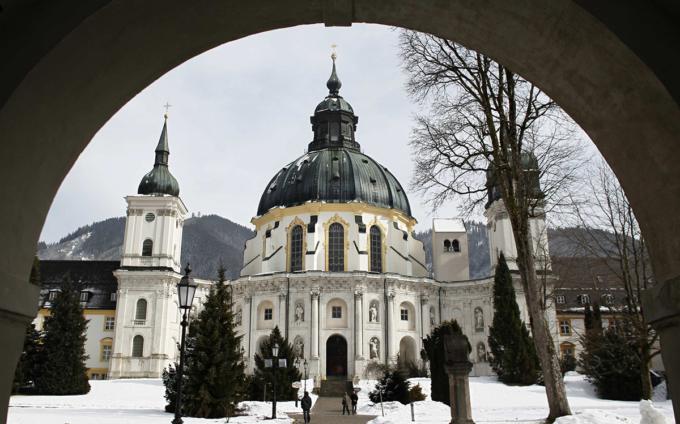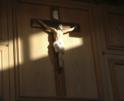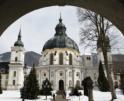
Faith
My regular visits have guided how I approach my home and family life, which, though not a monastery itself, can emulate the regular rhythm of prayer, work, and fraternity.
In his "Rule," St. Benedict remarks that a monastery is never without guests. Though he wrote this line 1,500 years ago, the monastery remains alluring even for modern visitors. The monks leave the normal course of the world behind to seek first the Kingdom of God. But the world has a way of coming to see what they're up to, enjoying visits as an oasis from the loud and busy bustle of life. Monasteries have served as bastions of prayer throughout history and culture, forming schools, libraries, hospitals, hostels, pilgrim shrines and centers of agriculture and manual crafts.
I'll never forget my first experience of a Benedictine monastery. I studied abroad in Poland during my sophomore year of high school and went on an outing with Catholic scouts through the Tatra mountains, stopping in Krakow on our way home. Outside the city, we were walking along the Vistula River when the great abbey of Tyniec appeared, standing firmly on top of cliffs for 1000 years. Rather than walking around by the road, being intrepid teenage boys, we scaled the rocky crag to reach the courtyard in front of the historic church. We were received warmly, with a monk explaining the monastery's routine of prayer, and, after Vespers, they treated us with their customary (and delicious) hospitality.
In my senior year of high school, I was drawn to a local Cistercian Abbey for a few visits, including an entire week praying and working with the monks. After that, you could say that I was hooked for life. Although I can't embrace the monastic life entirely, being married with six children, the Benedictine life has remained a constant source of inspiration and encouragement, eventually leading to my becoming an oblate at Clear Creek Abbey in 2010. Since then, I've visited dozens of monasteries with my family, both in the US and Europe, continually drawn back to the peacefulness and beauty of the Work of God, the monks' chanted prayer, offering a rejuvenating solace.
If you've never experienced this monastic solace, this year may be the right time for a first visit, whether a day visit or an extended retreat. Since the monks have expected a stream of visitors since the days of St. Benedict, one of the monks serves as the Guestmaster, who oversees lodging and meals for guests, and assists those stopping in for the day. My regular visits have guided how I approach my home and family life, which, though not a monastery itself, can emulate the regular rhythm of prayer, work, and fraternity.
To prepare for a visit, you might appreciate a new deep dive into the life of a great French monastery, the Abbey of Fontgombault, which, due to its large number of vocations, has founded four other monasteries, including Clear Creek in Oklahoma, in 1999. Nicholas Diat, who explored numerous monasteries in France in his masterful work, "A Time to Die: Monks on the Threshold of Eternal Life," now offers us "The Great Happiness: Life of the Monks" (Our Sunday Visitor, 2024). Diat visited Fontgombault often, detailing his own impressions and conversations with the monks.
The beginning of the book immerses the reader into the daily rhythm of prayer, based upon the Psalms, as it shapes the year alongside the fluctuating seasons of central France. Founded in 1091, the monastery's beautiful Romanesque Church testifies to centuries of prayer, though not unbroken. The abbey was ravaged by the religious wars following the Reformation and was dissolved during the French Revolution. The black monks of St. Benedict returned only in 1948, coming from Solesmes, the great center of Gregorian chant. The cavernous church, though breathtaking, also makes for icy conditions in the winter, offering a rigorous penance for the monks and any brave visitors.
The monks may seem superhuman to us with their constant regimen and difficult ascetical practices, but the book unveils the real humanity of the monks as they seek to immerse themselves completely in God. "When a man enters the monastery, in his baggage he also carries his past, his passions, his political ideas, his family history. On the day of entry into the enclosure, there's no need to expect a miraculous break. Over time, the center of gravity of his personality shifts. Because the monk is fascinated by God, he is stretched toward him. The desire to enter the monastery betrays a deep call from God that will focus his entire new life. Passions, skills and professions take a back seat" (113). The book often touches on the gentleness, peace and joy shown by the monks, even as they remain guarded by a reserve that indicates their hiddenness in God.
Diat speaks from experience about the power of a monastic visit: "Guests feel happy spending a few days at Fontgombault. By observing the monks, they feel like they are putting their lives back in order. The experience is paradoxical because they can never live in the world like Benedictines. But the retreats are cleansing. People come out more rested" (196).
Don't we all need this kind of rest? Not only does it refresh us for the present, but it anticipates the eternal rest of Heaven. Nothing on earth can capture it perfectly, and it can't be found simply by visiting a certain place. Nonetheless, the life of the monastery might just be the closest thing to gazing into it, a little window into eternity, witnessing a life given over completely to the praise and glory of God.
Recent articles in the Faith & Family section
-
Presentation of the LordFather Robert M. O'Grady
-
Life is beautifulArchbishop Richard G. Henning
-
Faith to Rebuild in PakistanMaureen Crowley Heil
-
Scripture Reflection for Jan. 26, 2025, Third Sunday in Ordinary TimeFather Joshua J. Whitfield
-
Why you should visit a monasteryDr. R. Jared Staudt























